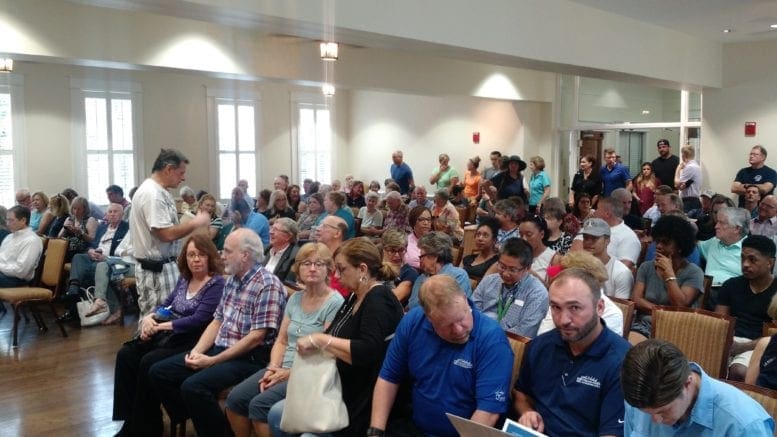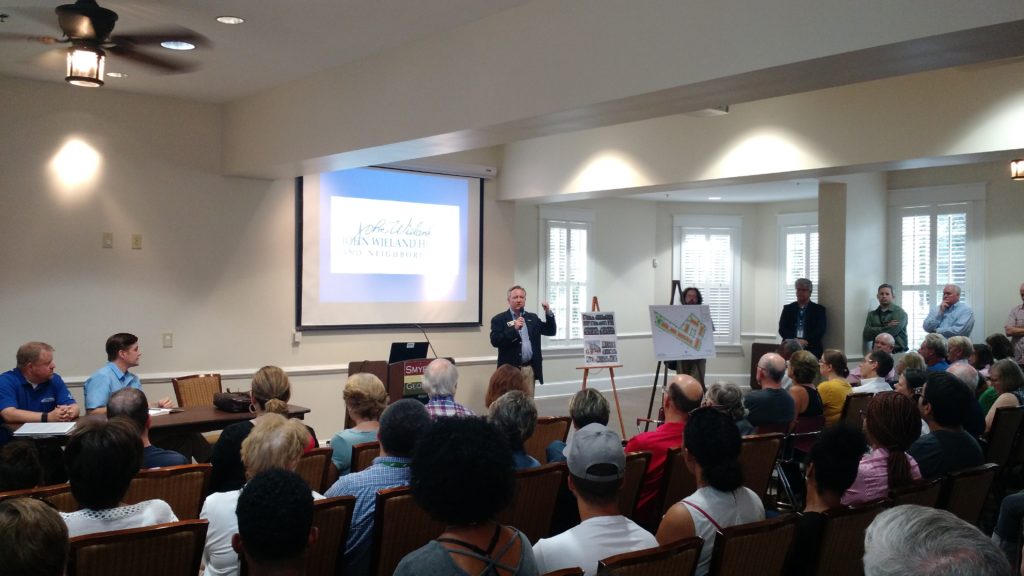A group representing John Wieland Homes and Neighborhoods along with Smyrna City Councilman Doug Stoner got plenty of blowback about a potential townhome development on Atlanta Road Tuesday night.
The meeting at Brawner Hall began 15 minutes late as extra chairs were brought in to accommodate the overflow crowd. When it finally began, the standing-room-only group had plenty to say about the project, almost all of it against the project.
“What can we as homeowners do to convince you that we don’t want this?” asked Mary Joe Franchini to thunderous applause.
PulteGroup Inc., which owns the John Wieland brand, aims to build 43 townhomes on three lots between the Reed House and Charter Bank at the southwest corner of Atlanta Road and Concord/Spring roads. Right now, the lots contain two houses built in 1928, and one built in 1913.
Signs have been in place for weeks notifying residents of the potential redevelopment, which would require a rezoning of the property from R-15-LC to RTD-Cond. Smyrna’s planning and zoning board will take it up the issue at its Aug. 14 meeting, with the full city council expected to take a vote Sept. 18.
If Tuesday night was any indication, both can expect a good deal of public comment when the time comes.
James Balli, the attorney representing Pulte, gave a presentation to start the meeting, noting the townhomes could go for between $600,000 and $800,000 based on comparable properties on Peach Lane. He also pointed out that the southernmost of the three lots is already zoned for commercial use, meaning it could potentially house a laundromat, animal hospital or parking garage.
“We think a high-quality community would be the best use for this property,” Balli said.
Audience members peppered Balli on both points, with one saying the comparable properties he listed include views of the Atlanta skyline, which won’t be found at the new development, and the other asking why Balli chose only to list businesses perceived as undesirable in his presentation. Both drew loud applause from the rest of the crowd.
Laura Lockwood, president of the Forest Hills Preservation Group, said she’s opposed to the development because it will impinge on the privacy of many of the homes in her neighborhood, which lies at the back of the Atlanta Road property.
A few audience members also asked how the proposed use as new townhomes would improve the property’s current use by a group of psychiatrists, not to mention two pre-World War II homes.
The needed rezoning would reclassify the parcels from medium density residential to urban residential with a density of 7.83 townhomes per acre.
Danny Figueroa presented a Change.org petition with over 1,000 signatures urging Smyrna’s city council to reject the rezoning.
“Why 43 huge townhomes?” he said. “We don’t need any more high-density housing… it’s getting ridiculous.”
Another attendee even noted how, from a certain angle, an overhead view of the development resembled a fist with its middle finger pointing up.
Traffic was a common theme of the night. Audience members asked several questions about how cars would get in and out of the complex and how it would impact the city’s traffic on the whole.
However, Stoner responded that he can’t legally reject a rezoning just based on traffic, and that doing so would result in a lawsuit from the developer that would cost the city money.
One person in the crowd responded that Stoner should reject the rezoning based on traffic anyway, and just say it was for some other reason.
Balli and Stoner explained to the group that, for economic reasons, the property is almost certain to be developed at some point. Stoner said there is virtually no chance the city will buy the properties, like it did with the nearby Reed House, but hinted that a compromise could be in order by asking if a lower-density development might work instead.
“These homes are not a designated historic site,” he said. “Had the Reed House not been purchased by the city, it likely would have been part of this development… The city is not purchasing any of this property.”








